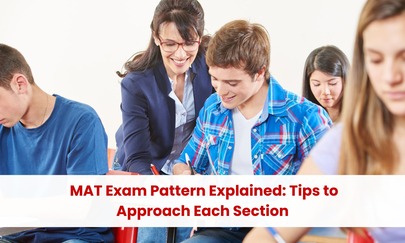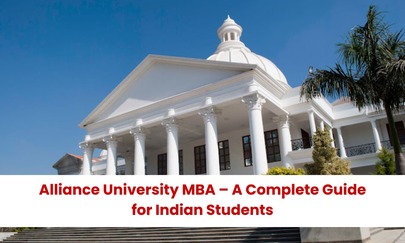
In India, prospective management professionals frequently struggle to decide between the different entrance tests for admission to MBA programs. The MAT (Management Aptitude Test) and ATMA (AIMS Test for Management Admissions) are two of the most common options. Although many B-schools around the nation accept both tests, each has special benefits, features, and formats. In order to assist you in choosing the test that best suits your preparation preferences and professional goals, this blog attempts to present a thorough comparison of the ATMA and MAT.
Overview of ATMA
The Association of Indian Management Schools (AIMS) runs ATMA, which is recognised by more than 750 management schools in India. The test is known for focussing on analytical skills and is meant to check candidates' thinking, comprehension, and math skills.
Key Features of ATMA:
- Frequency: Conducted multiple times a year (typically in February, May, July, and August).
- Eligibility: Graduates from any discipline are eligible to apply.
- Exam Mode: Online (Computer-Based Test).
- Duration: 3 hours.
- Sections:
- Analytical Reasoning Skills (2 sections)
- Verbal Skills (2 sections)
- Quantitative Skills (2 sections)
- Scoring: A total score of 800 with sectional scores provided.
- Application Fee: Approximately ₹2000.
- Difficulty Level: Moderate.
Overview of MAT
MAT, conducted by the All India Management Association (AIMA), is one of the oldest MBA entrance exams in India. It is accepted by over 600 B-schools and is known for its flexibility in terms of test-taking modes.
Key Features of MAT:
- Frequency: Conducted four times a year (February, May, September, and December).
- Eligibility: Graduates in any discipline; final-year students are also eligible.
- Exam Modes:
- Computer-Based Test (CBT)
- Paper-Based Test (PBT)
- Internet-Based Test (IBT)
- Duration: 2 hours.
- Sections:
- Language Comprehension
- Mathematical Skills
- Data Analysis and Sufficiency
- Intelligence and Critical Reasoning
- Economic and Business Environment (GK)
- Scoring: A composite score out of 800 (excluding GK).
- Application Fee: Approximately ₹1750 for one mode; additional fees apply for multiple modes.
- Difficulty Level: Easy to moderate.
Comparison Between ATMA and MAT
1. Exam Structure and Content
- ATMA: Focuses heavily on reasoning and quantitative skills, offering two separate sections for analytical reasoning and verbal skills. The syllabus is concise and focuses on core aptitude.
- MAT: Offers a broader range of topics, including general knowledge (Indian and Global Environment), which is not a part of ATMA. MAT caters to candidates who are comfortable with a wider variety of subjects.
2. Frequency and Flexibility
- ATMA: Conducted multiple times a year, providing flexibility for candidates to choose a convenient date.
- MAT: Also held four times annually but offers unparalleled flexibility with three test-taking modes: CBT, PBT, and IBT.
3. Exam Duration
- ATMA: The exam lasts 3 hours, slightly longer than MAT, and is intensive in its approach.
- MAT: Of 2 hours, MAT’s shorter duration might appeal to candidates who prefer a less time-intensive test.
4. Difficulty Level
- ATMA: Considered moderately difficult with an emphasis on reasoning and analytical skills.
- MAT: Rated as easy to moderate, making it a preferred choice for students seeking a less rigorous test.
5. Acceptance by B-Schools
- ATMA: Accepted by over 750 institutes, including Tier 1 and Tier 2 B-schools.
- MAT: Accepted by more than 600 institutes but is often considered a benchmark for admissions into Tier 2 and Tier 3 colleges.
6. Scoring Pattern
- ATMA: Provides scores for each section and an overall score out of 800. Negative marking applies for incorrect answers.
- MAT: The composite score excludes the GK section and is calculated out of 800. Negative marking is applicable.
7. General Knowledge Component
- ATMA: Does not include a general knowledge section, making it more suitable for candidates who wish to focus solely on aptitude-based questions.
- MAT: Includes a GK section, which, though not included in the composite score, is considered by some B-schools during the selection process.
Who Should Opt for ATMA?
ATMA is ideal for candidates who:
- Have strong analytical and quantitative skills.
- Prefer a concise syllabus focused on aptitude.
- Are targeting specific B-schools that prioritize ATMA scores.
- Wish to avoid questions related to general knowledge.
Who Should Opt for MAT?
MAT is better suited for candidates who:
- Prefer flexibility in test-taking modes (CBT, PBT, IBT).
- Are comfortable with a broader syllabus, including GK.
- Aim to apply to a wide range of B-schools, especially Tier 2 and Tier 3 colleges.
- Want a relatively less intensive testing experience.
Tips for Preparing for ATMA and MAT
Regardless of which exam you choose, effective preparation is key to success. Here are some tips to help you ace your test:
- Understand the Syllabus: Familiarize yourself with the syllabus and exam pattern for your chosen test. Prioritize topics based on your strengths and weaknesses.
- Time Management: Practice managing your time during mock tests. Ensure you allocate sufficient time to each section.
- Practice Mock Tests: Take full-length mock tests to simulate exam conditions. Analyze your performance to identify areas for improvement.
- Focus on Weak Areas: Devote extra time to topics where you need improvement. Use study materials and resources tailored to the specific exam.
- Stay Updated: For MAT, regularly read newspapers and current affairs to prepare for the GK section.
- Revise Regularly: Consistent revision is crucial to retaining concepts and improving accuracy.
Final Thoughts
In the end, your personal qualities, professional objectives, and the B-schools you want to target will determine whether you choose ATMA or MAT. MAT provides more flexibility and a wider reach, but ATMA is best for applicants seeking a targeted aptitude test. Before choosing, consider your preferred method of preparation, level of familiarity with the curriculum, and the results you hope to achieve. You can succeed in either exam and move closer to realising your MBA goals with careful study and a well-defined plan.
Any question in your mind?
Connect to our counsellor: 8826807515












